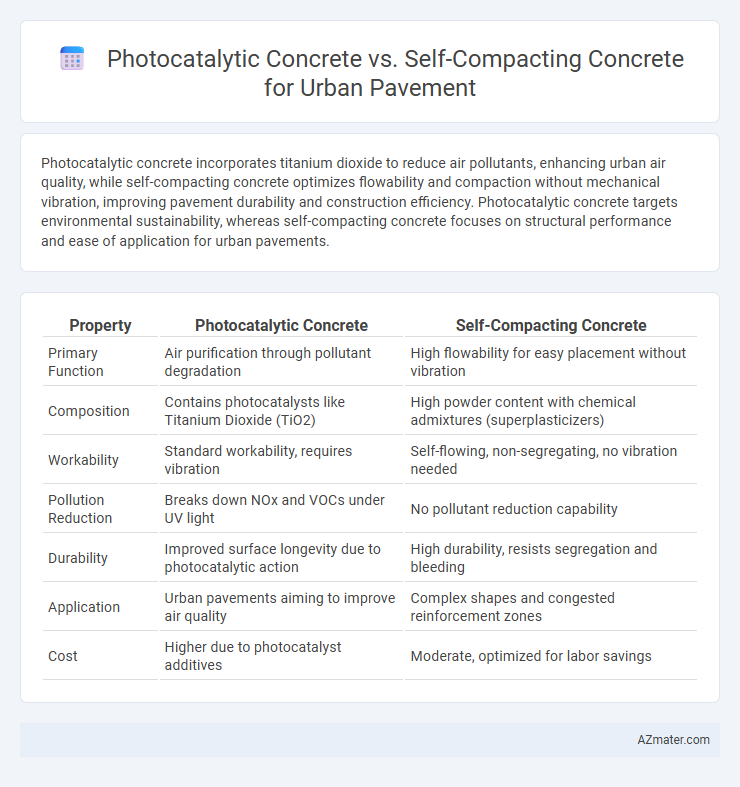Photocatalytic concrete incorporates titanium dioxide to reduce air pollutants, enhancing urban air quality, while self-compacting concrete optimizes flowability and compaction without mechanical vibration, improving pavement durability and construction efficiency. Photocatalytic concrete targets environmental sustainability, whereas self-compacting concrete focuses on structural performance and ease of application for urban pavements.
Table of Comparison
| Property | Photocatalytic Concrete | Self-Compacting Concrete |
|---|---|---|
| Primary Function | Air purification through pollutant degradation | High flowability for easy placement without vibration |
| Composition | Contains photocatalysts like Titanium Dioxide (TiO2) | High powder content with chemical admixtures (superplasticizers) |
| Workability | Standard workability, requires vibration | Self-flowing, non-segregating, no vibration needed |
| Pollution Reduction | Breaks down NOx and VOCs under UV light | No pollutant reduction capability |
| Durability | Improved surface longevity due to photocatalytic action | High durability, resists segregation and bleeding |
| Application | Urban pavements aiming to improve air quality | Complex shapes and congested reinforcement zones |
| Cost | Higher due to photocatalyst additives | Moderate, optimized for labor savings |
Introduction to Modern Urban Pavement Solutions
Photocatalytic concrete incorporates titanium dioxide to reduce air pollutants through a chemical reaction activated by sunlight, making it an innovative urban pavement solution for improving air quality. Self-compacting concrete enhances construction efficiency with its high flowability, eliminating the need for mechanical vibration, and providing uniform surface finishes ideal for complex urban infrastructure. Both materials address different challenges in modern urban pavement, with photocatalytic concrete focusing on environmental benefits and self-compacting concrete optimizing structural performance and construction speed.
What is Photocatalytic Concrete?
Photocatalytic concrete is an innovative urban pavement material embedded with titanium dioxide (TiO2) nanoparticles that activate under sunlight to break down air pollutants such as nitrogen oxides (NOx) and volatile organic compounds (VOCs), enhancing air quality. This eco-friendly concrete not only provides structural support but also contributes to smog reduction and self-cleaning surfaces, offering significant advantages over traditional materials like self-compacting concrete. Its ability to mitigate urban pollution makes it a sustainable choice for city infrastructure aiming to improve environmental health.
Understanding Self-Compacting Concrete
Self-compacting concrete (SCC) for urban pavement offers superior flowability and high segregation resistance, enabling it to fill intricate molds and dense reinforcement without vibration. Its optimized mix design enhances durability and surface finish, reducing maintenance in high-traffic urban areas. Compared to photocatalytic concrete, SCC prioritizes workability and structural integrity, making it ideal for rapid and complex urban construction projects.
Environmental Benefits Comparison
Photocatalytic concrete enhances urban pavement sustainability by actively reducing air pollutants like nitrogen oxides through titanium dioxide nanoparticles, improving air quality and decreasing urban smog formation. Self-compacting concrete contributes to environmental benefits by minimizing construction waste and reducing energy consumption due to its superior flowability, which eliminates the need for mechanical vibration. Both materials promote eco-friendly urban infrastructure, with photocatalytic concrete offering dynamic pollution mitigation and self-compacting concrete ensuring efficient resource use and reduced carbon footprint during installation.
Mechanical Properties and Performance
Photocatalytic concrete enhances urban pavement by providing self-cleaning and pollution reduction through titanium dioxide additives, maintaining comparable compressive strength to traditional mixes with improved surface durability. Self-compacting concrete offers superior workability and uniformity, reducing porosity and enhancing mechanical properties like tensile strength and modulus of elasticity, which contribute to longer pavement life. Both materials improve urban pavement performance, but photocatalytic concrete focuses on environmental benefits while self-compacting concrete prioritizes mechanical robustness and ease of application.
Application Methods and Construction Efficiency
Photocatalytic concrete incorporates titanium dioxide in its surface layer, applied via spraying or pre-mixed formulations to enhance pollution reduction in urban pavements, requiring precise layering to maintain photocatalytic efficacy. Self-compacting concrete achieves high flowability without external vibration, facilitating faster placement and reducing labor demands in urban pavement construction, especially in complex formworks. The application of photocatalytic concrete demands meticulous surface exposure management, while self-compacting concrete optimizes construction efficiency by shortening curing times and simplifying formwork filling.
Durability and Maintenance Requirements
Photocatalytic concrete enhances urban pavement durability by breaking down pollutants and reducing surface wear through its titanium dioxide content, which also lowers maintenance needs by self-cleaning and mitigating urban grime accumulation. Self-compacting concrete provides superior durability through high-density compaction and uniformity without mechanical vibration, resulting in fewer voids and cracks, thus minimizing maintenance frequency and costs in urban environments. Comparing both, photocatalytic concrete excels in environmental maintenance with moderate structural resilience, while self-compacting concrete offers robust structural durability with standard cleaning requirements.
Cost Analysis: Initial and Long-term
Photocatalytic concrete typically incurs higher initial costs due to specialized titanium dioxide additives and advanced manufacturing processes compared to self-compacting concrete, which generally uses conventional materials and admixtures. Long-term cost benefits of photocatalytic concrete emerge from its ability to reduce urban air pollution and lower maintenance expenses through its self-cleaning properties, whereas self-compacting concrete offers cost savings by minimizing labor and improving construction speed. Evaluating urban pavement projects should consider lifecycle cost analysis to balance higher upfront investment in photocatalytic concrete against its potential environmental and maintenance savings over time.
Urban Aesthetic and Design Flexibility
Photocatalytic concrete enhances urban aesthetics by actively reducing air pollution and maintaining cleaner surfaces, contributing to a visually appealing environment. Self-compacting concrete offers superior design flexibility through its high flowability, enabling intricate shapes and complex patterns for creative urban pavement solutions. Both materials support sustainable urban design, but photocatalytic concrete emphasizes environmental functionality, while self-compacting concrete prioritizes versatile structural aesthetics.
Choosing the Right Concrete for Urban Pavements
Photocatalytic concrete enhances urban pavement by reducing air pollution through titanium dioxide additives that break down pollutants, improving air quality in dense city environments. Self-compacting concrete offers superior workability and faster placement without vibration, ideal for complex or congested urban construction sites requiring efficient, durable pavement. Selecting the right concrete depends on balancing environmental benefits like pollution reduction with construction efficiency and structural performance tailored to specific urban infrastructure needs.

Infographic: Photocatalytic concrete vs Self-compacting concrete for Urban pavement
 azmater.com
azmater.com